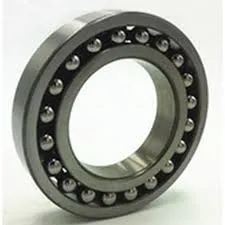
ታኅሣ . 29, 2024 14:41 Back to list
angular contact ball bearings
Understanding Angular Contact Ball Bearings
Angular contact ball bearings are a critical component in various mechanical systems, serving to support radial and axial loads simultaneously. This unique design allows them to be used in high-speed applications, including machine tools, aviation, and automotive industries. Their ability to handle both kinds of loads makes them indispensable in many engineering applications.
What Are Angular Contact Ball Bearings?
Angular contact ball bearings consist of inner and outer rings, balls, and a cage that holds the balls in place. The key distinction that sets them apart from other bearing types is the angle at which the balls contact the races. This angular setup allows the bearings to accommodate thrust loads in one direction while also supporting radial loads. The angle of contact is typically between 15° to 40°, depending on the design and the application's requirements.
Working Principle
The design of angular contact ball bearings enables them to handle combined loads efficiently. When a radial load is applied, the bearings distribute the load across the contact angle, allowing the raceways to maintain contact with the balls under varying conditions. This feature is particularly advantageous in applications subject to both axial and radial stresses. The arrangement allows for efficient operation at high speeds due to the reduced friction and improved load distribution.
Types of Angular Contact Ball Bearings
There are several types of angular contact ball bearings configured to meet different load characteristics
1. Single-row Angular Contact Bearings These are the most common type and are designed to accommodate loads primarily in one direction. When arranged in pairs, they can handle both axial loads effectively.
2. Double-row Angular Contact Bearings These have two rows of balls and can support heavier loads. They are often used in applications where high axial and radial load capacities are desirable.
angular contact ball bearings

3. Four-point Contact Bearings These allow for load in multiple directions and can support moment loads, making them suitable for specialized applications.
4. Face-to-Face and Back-to-Back Arrangements These configurations of single-row bearings improve load capacity and ensure greater stiffness, useful in precision machinery.
Applications
Angular contact ball bearings find their applications in various fields. In the automotive industry, they are used in wheel hubs, steering columns, and gearboxes, where they handle both axial and radial loads effectively. In machine tools, these bearings support spindles that turn at high speeds, where precision and stability are crucial. Additionally, they are used in electrical motors, pumps, and aerospace devices.
Advantages
The advantages of angular contact ball bearings are numerous
- High Load Capacity Their angular design allows them to support heavier loads than standard radial bearings. - Reduced Friction With optimized design to minimize contact friction, they can operate efficiently at high speeds, contributing to longer service life. - Versatility They can be configured to meet specific load and speed requirements, making them highly adaptable for different engineering challenges. - Stability The arrangement of the balls provides greater rigidity and less deformation under load, contributing to enhanced operational stability.
Conclusion
In summary, angular contact ball bearings are sophisticated mechanical components designed to handle complex loading conditions in various applications. Their unique construction allows them to accommodate both radial and axial loads, making them essential in industries ranging from automotive to aerospace. With their ability to operate at high speeds while supporting significant loads, they exemplify the intersection of engineering innovation and practical functionality. As technology advances, the use of angular contact ball bearings will undoubtedly continue to grow, fortifying their role in the backbone of many modern mechanical systems.
By understanding the dynamics and advantages of angular contact ball bearings, engineers and designers can make informed choices when selecting components for their applications, ensuring efficiency, reliability, and performance excellence.
Latest news
-
Spherical Roller Bearings Applications: Heavy Duty, Self-Aligning
NewsAug.30,2025
-
Premium Deep Groove Ball Bearings | High Speed & Reliability
NewsAug.29,2025
-
Durable Scaffolding Clamps - Secure & Reliable Tube Connectors
NewsAug.28,2025
-
Common Failures in Thrust Ball Bearings and Solutions
NewsAug.22,2025
-
How Tapered Roller Bearings Can Take Shock Loads
NewsAug.22,2025
-
Angular Bearings in High-Precision Spindles
NewsAug.22,2025
